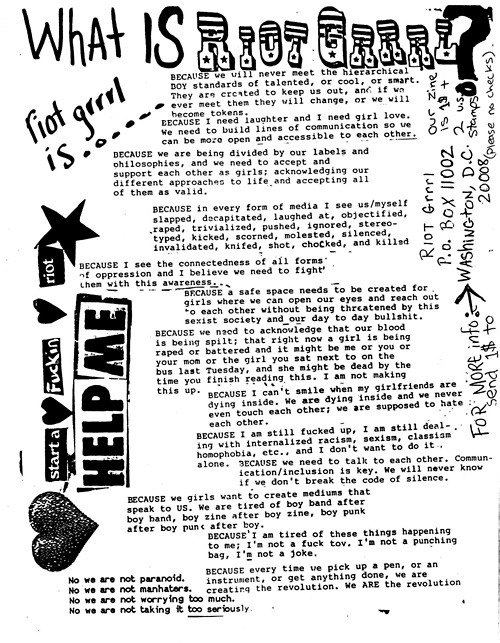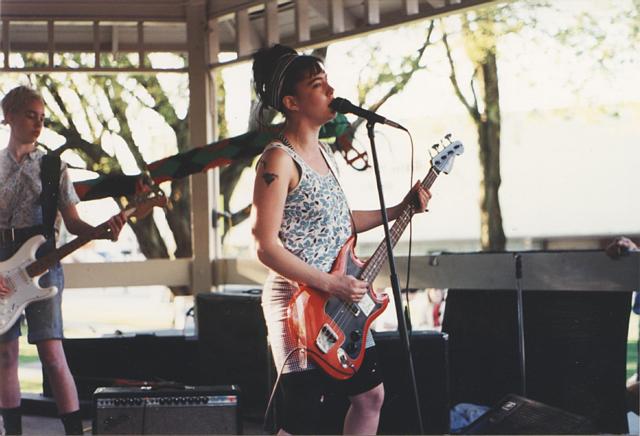Tonight (Wednesday 15 January 2014) I’m heading to the Corner Hotel in Richmond, Melbourne to see The Julie Ruin.
For me – and I suspect for others – it is not only a chance to see an excellent, original and wildly entertaining current band. It’s also an opportunity to see a live show featuring Kathleen Hanna and Kathi Wilcox, two members of the 1990s band Bikini Kill and pioneers of the riot grrrl movement.
(Sorry for the video/sound quality, but hey – it’s early ’90s punk.)
This has sent me back to the book released by the Feminist Press last year, The Riot Grrrl Collection, edited by Lisa Darms, Senior Archivist at the Fales Library & Special Collections at NYU, and founder of the Fales Riot Grrrl Collection. Rather than providing retrospective interpretation (there is only a short introduction to the collection from Darms and a brief personal essay by Johanna Fateman), The Riot Grrrl Collection reproduces a roughly chronological selection of the zines, flyers and other ‘ephemera’ which formed such an important part of the scene.

What Is Riot Grrrl? by Kathleen Hanna. From Hanna and Horovitz (Tumblr): http://hannahorovitz.tumblr.com/post/20179920141/1991-riot-grrrl-manifesto-written-by-kathleen (Accessed: 14 January 2014).
And, coincidentally, I’m also reading Doing Recent History, edited by Claire Bond Potter and Renee C. Romano, which explores “the challenges of writing histories of recent events where visibility is inherently imperfect, hindsight and perspective are lacking, and historiography is underdeveloped.”
Though I didn’t really recognise it at the time, I encountered these challenges in the early 1990s as a school history student. We were asked to write about some type of recent history (I don’t remember the brief exactly) and I picked riot grrrl, because it was:
about Frustration. Frustration in music. Frustration in living, in being a girl, in being a homo, in being a misfit of any sort. In being a dork, you know, the last kid to get picked for the stupid kickball team in grade school. Which is where this whole punk rock thing came from in the first place.
NOT from the Sex Pistols or L.A. But from the GEEKS who decided or realised (or something) to “turn the tables” so to speak, and take control of their (our) lives and form a Real underground.*
As you might gather, I wasn’t one of the ‘cool kids’ at my conservative all-boys private school.
So I wrote an impassioned piece about the revolutionary power of this music and the surrounding activist feminist/misfit movement, based primarily on booklets from CDs and some articles from the music press (most of which were from the UK, a long way from Olympia and Washington, D.C. where most of the bands, fans and zines were based). I don’t have a copy of what I wrote, but know I didn’t get a great mark because it was closer to a teen zine rant than a history essay. A relatively mild act of non-conformity toward my teacher and school from one of the kids who didn’t fit their system very well.
If it had been a real attempt at history, I would have encountered many of the issues explored by Potter and Romano. I was (far, far) too emotionally involved in my subject, it was still happening which made it difficult to judge the consequences, and there was little thoughtful analysis available placing the movement in the context of history, socio-cultural change, music or feminism.
But the biggest problem would have been the lack of primary sources. I was stuck in Melbourne, where the independent music press turned up on a ship a few months after being printed, alternative music released by independent labels was only available on import through a few independent record stores, and zines and other ephemera were mostly nowhere to be found.
Looking back digitally is a very different story. Even without the wonderful Riot Grrrl Collection, a Google image search for ‘riot grrrl zines‘ brings up results galore; YouTube is full of clips like the one above; Bikini Kill, Bratmobile and Sleater-Kinney albums and Kill Rock Stars compilations are all available at a click through iTunes; and there have been movies like the excellent The Punk Singer about Kathleen Hanna which screened at the Melbourne International Film Festival (and elsewhere around the world) last year.
As for new subcultures, the gap between events and the widespread dissemination of primary (and secondary) sources is closing fast. At times it feels almost instantaneous. There are a whole lot of potential consequences, for historians, archivists, and – not least – for the subcultures themselves and the very idea of ‘underground’ cultural movements.
I want to explore all those ideas further, but not in this post. This week I’m just going to listen to the music, browse the zines and watch the clips, happy that fans are preserving records digitally in the short to medium term; that artists like Hanna are aware of the importance of their own history (she donated her personal collection to the archive and helped with contacting other donors); and that archivists like Darms are working with a longer term view, ensuring that archival collections do not just reflect governments, corporations, powerful decision makers and ‘important people’. They also reflect misfits, dorks, geeks, and significant movements like riot grrrl that influenced and inspired people like me.
* Zine (excerpt), Chainsaw no. 2, Donna Dresch, circa 1990. The Tammy Rae Carland Zine Collection. In Lisa Darms (ed.), The Riot Grrrl Collection. The Feminist Press, NY. 2013: 23.
P.S. Though this is a somewhat nostalgic post, The Julie Ruin are more than Kathleen Hanna and Kathi Wilcox – they are also Kenny Mellman, Carmine Covelli and Sara Landeau – and Hanna and Wilcox have done a lot of other great work since the ’90s. If you get a chance to see The Julie Ruin in Melbourne, Sydney (The Factory, January 17th) or are lucky enough to be heading to MOFO at MONA (Hobart), I recommend checking them out.


Leave a Reply